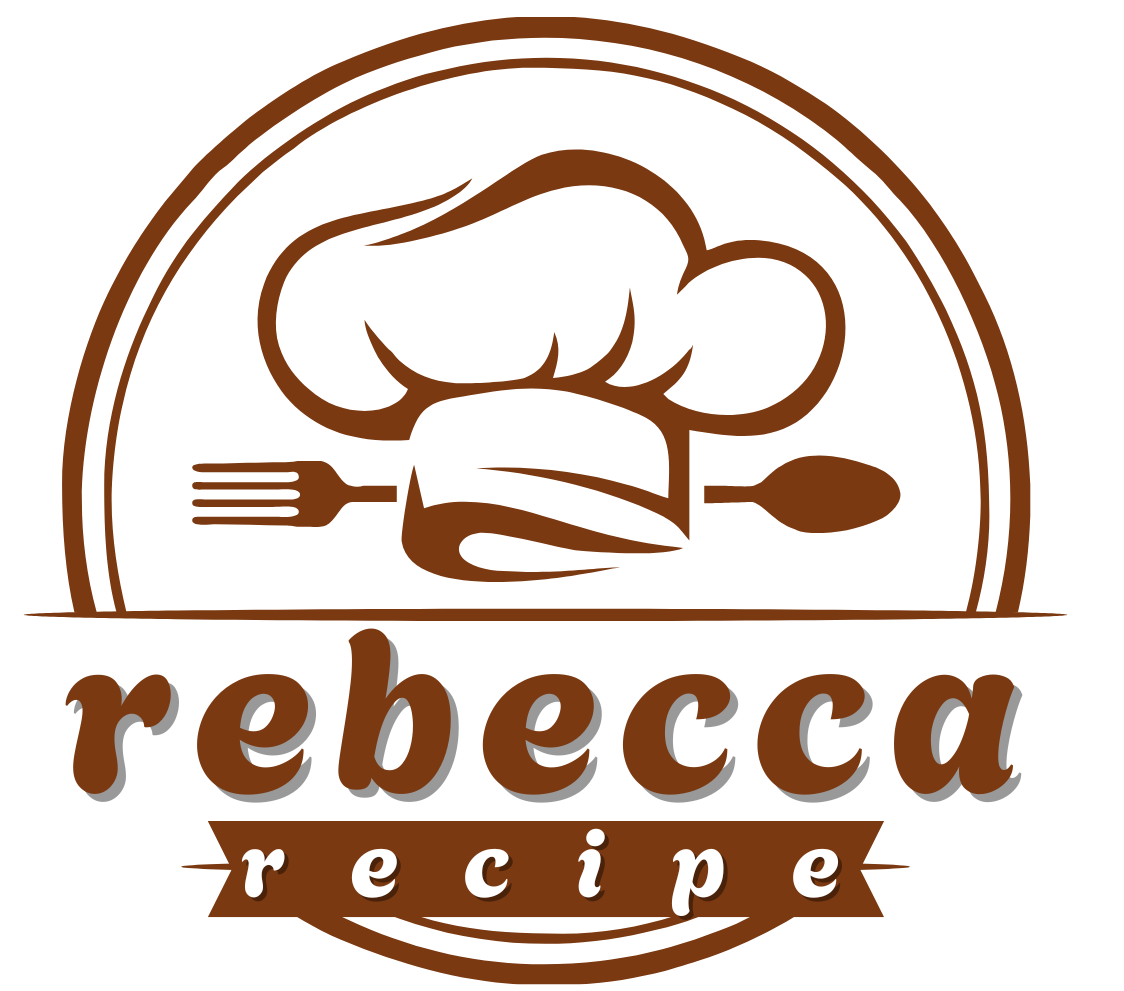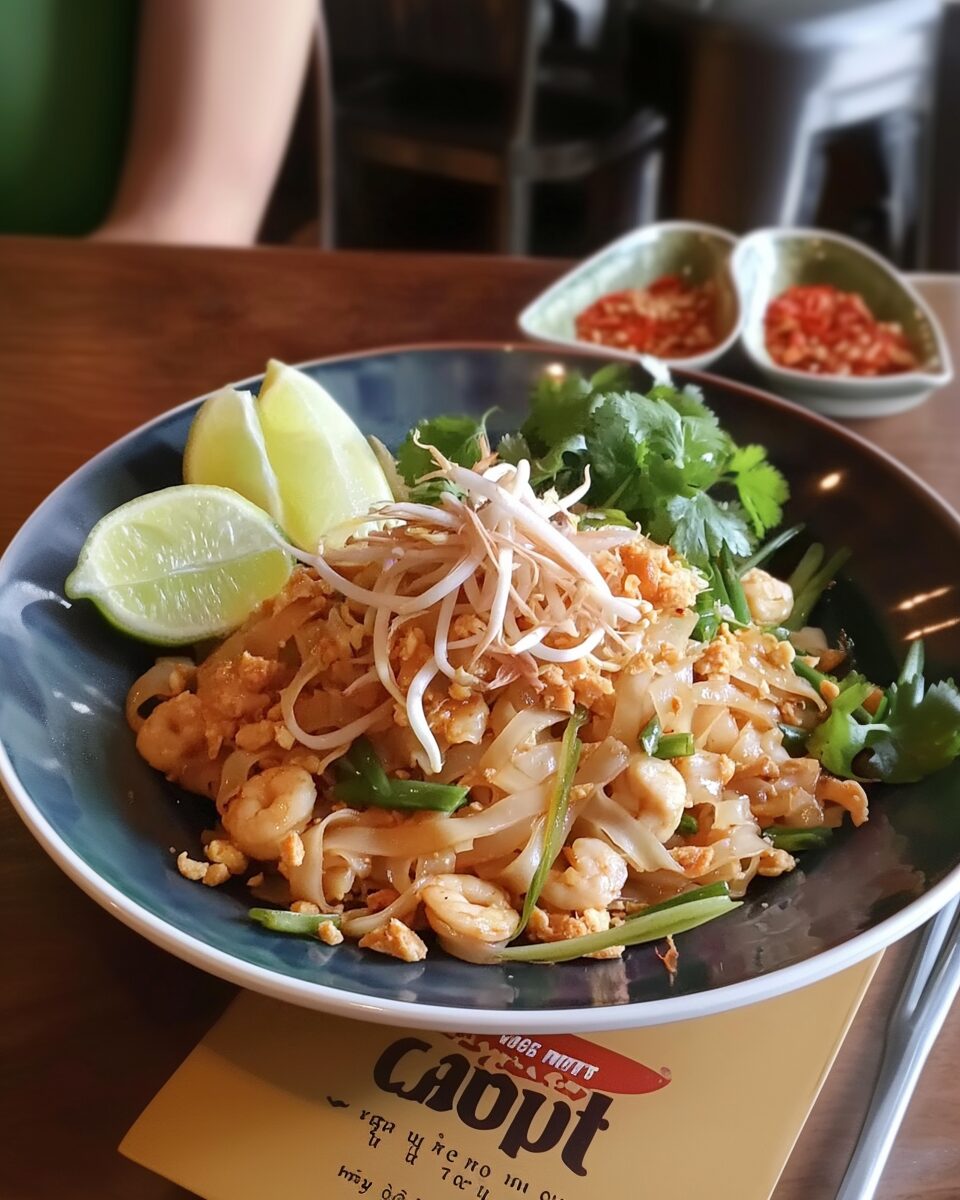Sukhothai Pad Thai is a distinctive variation of the traditional Thai stir-fried noodle dish, Pad Thai. Originating from the Sukhothai province in northern Thailand, this version offers a unique blend of flavors and textures that set it apart from other regional adaptations. The dish combines rice noodles with a savory sauce, tofu, shrimp, and a variety of garnishes, making it a delightful culinary experience.
Full Recipe:
Ingredients
- ½ cup white sugar
- ½ cup distilled white vinegar
- ¼ cup soy sauce
- 2 tablespoons tamarind pulp
- 1 (12 ounce) package dried rice noodles
- ½ cup vegetable oil
- 1½ teaspoons minced garlic
- 4 eggs
- 1 (12 ounce) package firm tofu, cut into ½ inch strips
- 1½ tablespoons white sugar
- 1½ teaspoons salt
- 1½ cups ground peanuts
- 1½ teaspoons ground, dried oriental radish
- ½ cup chopped fresh chives
- 1 tablespoon paprika
- 2 cups fresh bean sprouts
- 1 lime, cut into wedges
Directions
-
Prepare the Pad Thai Sauce: In a medium saucepan over medium heat, combine white sugar, distilled white vinegar, soy sauce, and tamarind pulp. Stir until the sugar dissolves and the mixture is well combined. Set aside to cool.
-
Soak the Rice Noodles: Place the dried rice noodles in a large bowl and cover them with warm water. Let them soak for about 30 minutes, or until they become pliable but not fully cooked. Drain and set aside.
-
Cook the Eggs: In a large skillet or wok, heat vegetable oil over medium heat. Add minced garlic and sauté until fragrant. Push the garlic to one side of the pan, pour the beaten eggs into the other side, and scramble until fully cooked.
-
Stir-Fry Tofu and Noodles: Add the firm tofu strips to the skillet and cook until they begin to brown. Add the soaked rice noodles and pour the prepared Pad Thai sauce over the mixture. Toss everything together, ensuring the noodles are evenly coated with the sauce.
-
Add Peanuts and Radish: Stir in ground peanuts and ground dried oriental radish. Continue to toss the mixture until all ingredients are well combined.
-
Garnish and Serve: Remove the skillet from heat. Sprinkle chopped fresh chives and paprika over the dish. Serve with fresh bean sprouts and lime wedges on the side, allowing individuals to garnish their servings as desired.
Nutritional Facts
- Calories: Approximately 714 kcal per serving
- Protein: 23g
- Carbohydrates: 62g
- Fat: 44g
- Fiber: 4g
- Sodium: 2161mg
- Sugars: 30g
Origins of Pad Thai and the Sukhothai Variation
Pad Thai, or “Thai-style stir-fried noodles,” is a dish with a fascinating history. It was popularized in Thailand during the 1930s, when the government under Prime Minister Plaek Phibunsongkhram sought to promote a national identity through food. The Thai government aimed to simplify and modernize the culinary landscape, creating a unifying dish that would be both affordable and representative of the country’s unique culinary heritage. Pad Thai became a central part of this initiative and was promoted as a national dish.
However, the origins of Pad Thai go beyond the boundaries of its 20th-century reinvention. The concept of stir-frying rice noodles with various seasonings and ingredients dates back centuries in Chinese culinary traditions, as rice noodles were widely used in Southern China and Southeast Asia. In the case of Pad Thai, the influence of Chinese immigrants to Thailand played a significant role in shaping the dish. Over time, it absorbed local ingredients and flavors, evolving into the iconic dish we know today.
While the origins of Pad Thai can be traced to the fusion of Chinese and Thai culinary techniques, the Sukhothai style of Pad Thai is believed to have emerged from the Sukhothai region, located in central Thailand. The area has a rich cultural and historical legacy, often referred to as the cradle of Thai civilization. In this region, traditional cooking methods have been passed down for generations, often incorporating local herbs, spices, and vegetables that give Sukhothai Pad Thai its unique flavor.
The Sukhothai version of Pad Thai is marked by its emphasis on fresh, locally sourced ingredients, and a more delicate approach to balancing flavors. It is characterized by a slightly sweeter taste, thanks to the use of sugar in the sauce, and the addition of tamarind gives it a tangy and tart edge. While the Bangkok version of Pad Thai can often be heavier and more flavorful with its use of fish sauce and shrimp paste, Sukhothai Pad Thai tends to be a bit lighter, with a focus on fresh ingredients and a more refined use of spices.
The Key Ingredients in Sukhothai Pad Thai
At the heart of any Pad Thai dish are the noodles, and for Sukhothai Pad Thai, rice noodles are used as the base. These thin, soft noodles are stir-fried to perfection, providing the perfect canvas for absorbing the rich flavors of the sauce. The choice of rice noodles is important because they maintain a delicate texture that complements the crunch of the fresh vegetables and the tenderness of the proteins, such as shrimp, tofu, or chicken.
The flavor profile of the dish is built around a balance of four key tastes: sweet, salty, sour, and spicy. The sweet component often comes from white sugar, which helps to round out the dish and give it a smooth finish. The saltiness comes from fish sauce, a staple in Thai cooking that adds depth and umami to the dish. The sourness is provided by tamarind paste, a tangy fruit that is often used in Thai cuisine to create a complex flavor. Finally, the heat comes from chili peppers, which provide a subtle spiciness that tingles the taste buds but doesn’t overwhelm the dish.
In addition to the basic components of the sauce, fresh vegetables are an essential part of the Sukhothai Pad Thai experience. Common vegetables used in the dish include bean sprouts, carrots, and chives. These vegetables provide both texture and flavor, adding a refreshing crunch that contrasts nicely with the softness of the noodles and the richness of the sauce. The dish is typically garnished with crushed peanuts, which add a nutty crunch and depth of flavor, as well as a squeeze of lime to bring out the fresh, zesty flavors of the dish.
Protein plays a significant role in Pad Thai, and in the Sukhothai version, tofu and shrimp are popular choices. Tofu adds a light, protein-rich element that soaks up the flavors of the sauce, while shrimp, often lightly seasoned and stir-fried, contribute a sweet, savory taste that enhances the overall dish. These proteins are stir-fried along with the noodles and vegetables to create a harmonious balance of ingredients.
Cooking Techniques and Preparation of Sukhothai Pad Thai
The cooking technique for Sukhothai Pad Thai is essential in bringing the dish to life. Stir-frying is the primary method used to cook Pad Thai, and this quick, high-heat technique helps preserve the freshness and crunch of the vegetables while allowing the noodles to soak up the rich flavors of the sauce.
In traditional Pad Thai preparation, the noodles are soaked first in warm water to soften them, but they are not fully cooked at this stage. The soaking process ensures the noodles are pliable and ready to be stir-fried. Once the noodles are ready, they are added to a hot wok or skillet, where they are stir-fried with the sauce and other ingredients. The high heat allows the noodles to caramelize slightly, absorbing the complex flavors of the tamarind and fish sauce while developing a subtle smokiness from the stir-frying process.
The key to making Sukhothai Pad Thai stand out is to make sure each ingredient is cooked to perfection. The garlic and chilies should be sautéed to release their aromatic flavors, while the eggs are scrambled separately to create a creamy texture that coats the noodles. The tofu and shrimp should be lightly stir-fried until golden and cooked through, adding both flavor and texture to the dish.
Another crucial element of preparing Sukhothai Pad Thai is achieving the right balance of flavors in the sauce. The sauce is typically made by combining sugar, tamarind paste, soy sauce, and fish sauce, and it is this sauce that gives the dish its signature taste. The key is to adjust the proportions to suit your personal preference, whether you like your Pad Thai sweeter, spicier, or more tangy.
The Cultural Significance of Pad Thai in Thai Cuisine
Pad Thai holds a special place in Thai cuisine and culture. It is considered a symbol of Thai street food and has a long history of being a quick, affordable meal for the masses. The dish has become so iconic that it is often the first dish that many people try when experiencing Thai food for the first time. Pad Thai is commonly found in street stalls, restaurants, and homes throughout Thailand, and it has become one of the most popular Thai dishes internationally.
The Sukhothai variation of Pad Thai, with its emphasis on fresh, locally sourced ingredients and a lighter flavor profile, represents the agricultural richness of the Sukhothai region. It showcases the diversity of Thailand’s culinary landscape, where regional variations of the same dish reflect local ingredients, cooking techniques, and cultural preferences. This regional adaptation of Pad Thai highlights the importance of fresh, seasonal ingredients and the subtle use of spices, which are key elements of Thai cuisine as a whole.
In Thailand, food is an integral part of daily life, and eating is a communal activity. Meals are often shared with family and friends, and food plays a key role in bringing people together. Sukhothai Pad Thai, like many traditional Thai dishes, is a reflection of this culture. It is a dish that is often enjoyed by people of all ages and backgrounds, and it embodies the Thai values of hospitality, generosity, and sharing.
Conclusion
Sukhothai Pad Thai is a delicious and vibrant dish that offers a refreshing take on the classic Pad Thai recipe. With its delicate balance of sweet, salty, sour, and spicy flavors, it brings together the best of Thai ingredients and cooking techniques. Whether you’re enjoying it in the heart of Thailand or recreating it in your own kitchen, Sukhothai Pad Thai offers a unique culinary experience that highlights the rich culinary traditions of the Sukhothai region.






